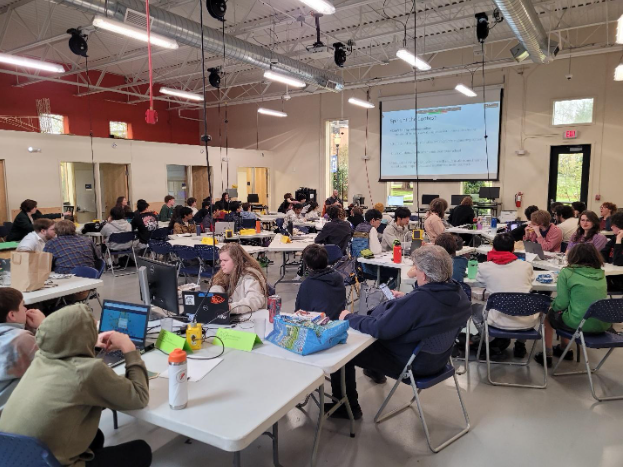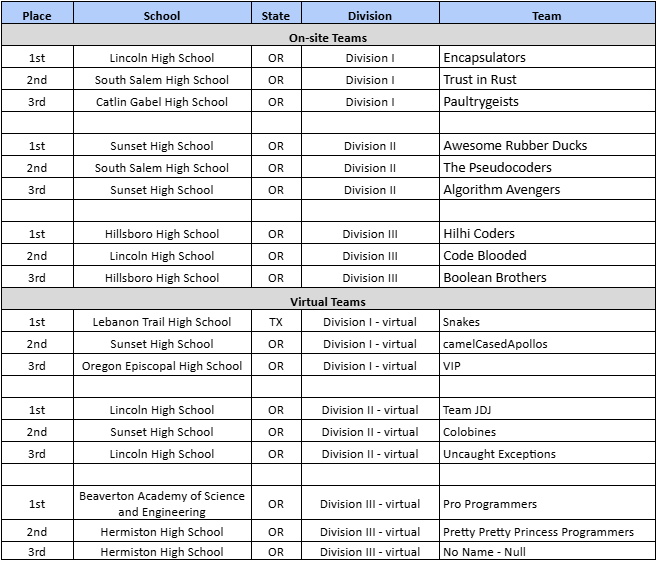By Linda Barney, Barney and Associates
The 2025 High School Programming Contest, sponsored and run by George Fox University's Computer Science & Cybersecurity Programs, was held on April 12 at George Fox University (GFU) in Newberg, Oregon. The contest included an on-site contest at GFU along with a virtual competition held at the same time. The competition programming problem sets were the same whether a team competed on site or virtually. In-person teams only competed against other in-person teams and virtual teams only competed against other virtual teams.
High school programming teams at the George Fox University High School Programming Contest
Why is the Programming Contest Important for High School Students?
“The high school programming contest is important because it fosters problem-solving skills, teamwork, and creativity while making coding exciting and competitive. It challenges students to apply logic and algorithms to real-world problems, enhancing their computational thinking. Competitions also build confidence, expose students to advanced concepts, and inspire interest in computer science as a possible career path. Students who participate learn to work under pressure, collaborate with peers, and gain recognition for their skills. Additionally, programming contests are also one way to help bridge the gender and diversity gap in tech by encouraging underrepresented groups to engage in programming. Overall, such events nurture future innovators and prepare students for academic and professional success in a tech-driven world,” states Dr. Brent Wilson, George Fox Professor of Computer Science & Cybersecurity, who organized the programming contest.
Why Did GFU Develop and Sponsor the Event?
Wilson indicates that, “The Oregon High School Programming Contest was started in 1986 at Oregon’s Willamette University by a dear friend named Dr. George Struble. Willamette hosted the contest for 30 years. At the time they were looking for a new host location, and with Dr. Struble's blessing, we moved the contest to George Fox University and it has been here for the past 9 years. We have expanded the contest to include beginning students by having three separate divisions based upon a student's skill level. This allows for students that are not Advanced Placement (AP) Computer Science students to also participate.”
Programming Contest Team Divisions
There were 23 on-site teams and 26 virtual teams in the programming competition. A single team includes two or three students. There are three divisions: Division I, II, and III:
Division III: Consists of students who are in the beginning stages of developing their algorithmic problem-solving skills. Division III teams may have competed before but probably only solved a small handful of problems.
Division II: Consists of teams who have been coding for at least a year and may have competed before. They probably would have completed over half of the problems but would have not previously placed 1st, 2nd, or 3rd in a similar division.
Division I: This division is a much harder division. The majority of the competition problems will be similar to programming contest problems at the college/university level. This division is truly for the advanced students who want to challenge themselves and "go for the glory."
TechStart Supports the High School Programming Challenge and K-12 Computer Science Education
“We at TechStart are very proud to have been involved with, and supported the High School Programming Contest, sponsored and run by George Fox University's Computer Science & Cybersecurity Programs. Geoge Fox graduates have leveraged their education for jobs at companies like Amazon, Nike, Boeing, McAfee, Microsoft, Intel, Oracle and more. This competition brought forty-nine high school student teams together both in person and remotely from all over Oregon even including two out of state remote teams, one from Texas and one from North Carolina. They all got first-hand experience on how to understand a problem and then write a computer program to solve the problem. Great experience for all, thank you George Fox,” states John Tortorici, TechStart Chair of the Board.


